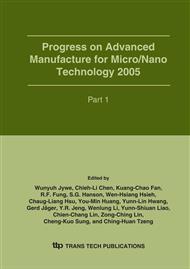p.43
p.49
p.55
p.61
p.67
p.73
p.79
p.85
p.91
Fabrication and Characterization of 3D Aspheric Microlenses with Arbitrary Surface Profiles Based on a Novel Excimer Laser Contour Scanning Method
Abstract:
This paper presents a new method for fabricating 3D microstructures with an excimer laser micromachining system. A novel mask contour scanning method is developed for obtaining precise 3D microstructures with pre-described continuous surface profile. Two different microlenses with spherical and aspheric surfaces profiles with dimension less than 200 μm are fabricated on polycarbonate (PC) samples. The surface profiles are measured and compared with their theoretical counterparts. Excellent agreements both in profile shapes and dimensions are achieved. The surface roughness (Ra) of the machined surfaces is also measured and is less than 10 nm. The machining profile accuracy and surface smoothness of this proposed micromachining method show great potentials in fabricating micro-optic components such as aspheric microlenses or microlens arrays.
Info:
Periodical:
Pages:
67-72
Citation:
Online since:
January 2006
Authors:
Keywords:
Price:
Сopyright:
© 2006 Trans Tech Publications Ltd. All Rights Reserved
Share:
Citation:


